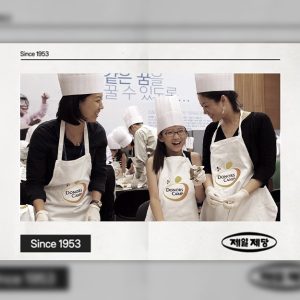It is not only parcels that parcel services deliver. To many, a career as a parcel delivers them a sense of professional pride and the satisfaction of knowing they are a valued and increasingly integral member of society. It is this philosophy that lies at the heart of Blue Parcel Delivery by CJ Logistics. Launched in Korea in July 2021 at SK View Apartments in Songdo, Incheon, Blue Parcel Delivery is a Corporate Social Value (CSV) delivery service model that champions hearing impaired delivery personnel. By presenting themselves at the doorways, these workers encourage people to broaden their conceptions of the capabilities of disabled workers, as well as the professions that are becoming available to them in and beyond logistics services.
Yoon Han-deuk, Head of Blue Delivery at the CL Logistics Communications (CSV) Team, was responsible for introducing this delivery model, doing so with a firm belief in the potential the concept has to make a profound social impact though a genuinely viable business model.
Blue Parcel Delivery’s Beginnings: How an On-Site Voice Gave Birth to an Innovative and Compassionate Project

Q. During the era of COVID-19, which saw the number of jobs available to socially disadvantaged groups decrease, the affirming influence of Blue Parcel Delivery – through its provision of high-quality jobs that disabled communities can engage in – is remarkable. Can you share your motivations behind launching this project?
Blue Parcel Delivery had its inception in another project. The idea occurred while working on the opening of a new base location for CJ Logistics’ representative CSV business Silver Parcel Delivery, which began its service in 2013 and is still operating today. Silver Parcel Delivery is a base type delivery model in which elderly people get involved in the final stage of the parcel delivering process, completing the delivery of goods using eco-friendly electric carts once standard delivery vehicles loaded with parcels have arrived at base locations in apartment complexes and traditional markets. This is a parcel role offered by our CSV business project that provides an average living wage of 900,000 KRW to elderly participants.
Q. So was SK View Apartments in Songdo, Incheon – the location where Blue Parcel Delivery was first introduced – originally an area earmarked for Silver Delivery?
In the early stages of the project, Silver Parcel Delivery was pushed forward as a base type delivery model. However, unlike previous Silver Parcel Delivery bases, Songdo in Incheon is an International Business District. Therefore, the number of elderly people in the socially disadvantaged community there was comparatively quite small, which created difficulties in getting the project off the ground. One day, though, the manager of Songdo Landmark’s post office suggested hiring the disabled instead. He put forward the idea that the parcel service is already carried out in the form of zero contact delivery, so there would be no problem with the quality of the delivery service if participants were trained to place parcels at the front of the household or doorway at the parcel’s destination.
I wondered about this and asked why he was suggesting a courier service for members of the disabled community, for whom employment is usually quite challenging, and I discovered that the manager’s son was himself hearing impaired. This man, as a parent, wanted his son to have the freedom to pursue a good job, and he wanted the same for his son’s friends and peers in the hearing impaired community. This was a heartfelt suggestion and I started to ponder the ways disabled people might be brought in to participate in sustainable, dependable work. As soon as I’d had this meeting with the delivery manager, we spent more than five hours hashing out the business model that came to be Blue Parcel Delivery.
Q. What were your priorities in executing this project?
After that first meeting with the delivery manager we visited the School for the Disabled people in Incheon. We were there with the aim of identifying individuals who could be employed in this project and we also visited the Incheon branch of the Korea Employment Agency for Persons with Disabilities to discuss how many people over the age of 20 might want to work in the delivery business. We wanted to get an idea of what kind of partnership we might be able to establish with prospective participants in the Incheon area.
It was also particularly important that we meet with officials from Incheon’s Yeonsu-gu Office and Incheon City Hall to express our desire to create consistent, sustainable jobs for disabled people on a regional basis. In addition to meeting with local authorities in this way, we took care to participate in residents representatives’ meetings in SK View Apartments in Songdo to inform the residents themselves about the positive work we hoped to do with Blue Parcel Delivery and establish a step-by-step public-private cooperation system.
There Are No Doubts About the Benefits Employing Disabled People and the Positive Impact Blue Delivery Can Bring About

Q. Blue Parcel Delivery could be described, then, as a distinctly evolved and developed version of the Silvery Delivery model. Which aspects of that model needed to change to fit the new requirements?
The Blue Parcel Delivery model works like this: after a parcel is transported to an apartment complex via the usual channels, a member of our Blue Parcel Delivery personnel finalizes the delivery by taking the parcel to the individual home or doorway. This is a carefully refined version of the Silver Parcel Delivery model. Silvery Parcel Delivery was itself such a success that it was introduced to the UN in recognition of its sustainability, but in order to adapt the model to help integrate disabled people into it, it was inevitable that we revise the public-private cooperation aspect and the support system. The most important thing was to ensure that it functioned well as a professional delivery service. If it worked efficiently and produced a positive and satisfied customer response then there was a great opportunity to overcome prejudice towards the disabled people and their capabilities.
To achieve this, we assigned one and a half buildings to each personnel member of Blue Parcel Delivery, or three buildings per two personnel. To better facilitate a smooth and accommodating working environment, a field manager system was adopted, which oversaw the delivery service base in the apartment complexes and deployed a professional field manager. This put systems in place that could immediately respond to any delivery problems or customer complaints that might occur.
As an extra measure, professional interpreters for hearing impaired personnel and work instructors for developmentally disabled personnel have been assigned to further accommodate smooth communication and task performance. We have also taken care to further simplify the delivery apps frequently used by Blue Parcel Delivery employees so that service can be fully carried out using only three app menus. This version of the app is set to be launched during the first half of this year.
Q. What efforts have been made to success as a CSV business?
It has always been crucial that Blue Parcel Delivery establish itself as a well-functioning, high-quality service in and of itself, so that it can pay its disabled employees a reliable living wage.
In this respect, SK View Apartments in Songdo was an optimal place to launch Blue Parcel Delivery. With a total of 2,100 households and 11 apartment buildings with an average of 34 floors, the location has the advantage of ensuring not only profitability but also a conducive delivery environment due to its high delivery density per unit area, plus the short delivery distances. This allows Blue Parcel Delivery employees to make a stable income while moving within a relatively small, manageable area. We also introduced electric carts to make horizontal movement easier and balance out the vertical accessibility provided by elevators, all with a view to making things more convenient for our personnel.

Q. You conducted a trial operation that has delivered 100,000 products in seven months since July last year. What did you gain from this testing period?
As would be expected from a new delivery job-providing project, we had to verify it through a trial operation prior to launch, to ensure the business’ stability.
Based on these seven months of trials, we confirmed the delivery errors and mistakes that had occurred during the initial delivery process were improving continuously and that the general satisfaction of the customers was growing steadily too. Based on our evaluations of how well our Blue Delivery staff took full charge of their designated delivery areas, we decided it would be viable to expand gradually.
Another positive aspect that helped the project succeed was the active cooperation of Songdo Landmark Post Office, which transformed its office into a Standard Workplace for the Disabled, a first for post offices. This generosity from the post office resulted in a much higher salary for Blue Parcel Delivery personnel than most disabled employment, which certainly helped with job satisfaction.
Above all, the support of team leaders and CSV team members was crucial to launching Blue Parcel Delivery. The challenges I presented them with may have seemed steep, or even reckless, but they actively supported the project and myself, which allowed this new delivery model to flourish.
Q. What was the driving force behind the stable launch of the project ?
Just like any other CSV projects, the operation doesn’t come down to company efforts alone. To realize Blue Parcel Delivery, many different project-adjacent companies, institutions and aspects of local government had to share and actualize common agendas and the social values the project stands for.
The stability of the models has been made possible through CJ Logistics itself by providing the parcel supply, the smooth on-site operation of the project by Songdo Landmark Delivery Office, support from professional interpreters, the education of members of the disabled community by the Incheon branch of the Korea Employment Agency for Persons with Disabilities, as well as the cooperation from local government in the Yeonsu-gu Office and Incheon City Hall.
The residents themselves, of course, must not go without mention. They supported the model idea by making their complex available to us to launch Blue Parcel Delivery, as well as by providing a free rest area for our staff. So this really was a big collective effort and I would like to express my gratitude to everyone involved for working so hard to make this project work.
Dreaming of K-CSV with Delivery Job Model
Q. What does Blue Parcel Delivery needs to be a sustainable CSV model?
Personally, in order for the CSV model to extend its sustainable and positive influence both internally and externally, I believe the solution must be found within the business itself.
In other words, in previous CSV businesses, the goal from the start was the realization of social values. Profitability was used to enable the participation of socially disadvantaged people. However, I’m an advocate for the opposite approach. I think we should look at the participation of vulnerable people as a legitimate way to address business problems. This is a very meaningful way to realize social values.
I think CSV officials need to be enabled to really let their hearts into their analyses of how business works. There is an increasing need to find a sweet spot: are there hidden problems in even stable and profitable business models, and which previously overlooked socially disadvantages groups might be sought to help address said problems? There is a synergy we can create there. In particular, I believe the willingness to be authentic will be more important to this decade of business than rushing to maximize jobs and sale might be.
Fortunately I was able to find this sweet spot with the Silver Delivery model. Silver Parcel Delivery started by solving the delivery problems in a particular region: that there were difficulties delivering parcels. By developing a business structure that hires elderly people in our society to deliver parcels to micro-regions, Silver Parcel Delivery proved to be a feasible way to create jobs for seniors, but importantly it also allowed them a sense of participation, so ultimately it supported the independence of seniors too.
Silver Parcel Delivery has been operating for nine years now, which has allowed the authentic spirit we have nurtured in CJ Logistics to gain attention not only in Korea but also abroad. When we started work on Blue Parcel Delivery we had an opportunity to evolve and develop the advantages this authenticity can bring to a business.
As the person in charge of operating this delivery job-providing model, I will strive to develop the heritage that began with Silvery Parcel Delivery and has now been carried through to Blue Parcel Delivery to show that this innovative K-CSV model really can be actualized and really is sustainable.

Q. Blue Delivery has just begun. What are its future operational plans?
We started Blue Parcel Delivery with SK View Apartments in Songdo and now we will expand the Blue Delivery business mainly around the Songdo, where new high-rise apartments with an average of 30 stories or more will be built. As part of this expansion we will exert efforts to discover and secure additional job opportunities for more disabled people to participate in.
We are also in preparation for the launch of the Orange Parcel Delivery project, which is a delivery service project for women taking a career break. We plan to launch these sustainable delivery jobs for women in this situation at Dongtan in Hwaseong, where numerous newly married couples and young families reside.
Q. Do you have what could be described as a final goal for these projects?
CJ Logistics has other projects in development alongside Blue Parcel Delivery. We plan to introduce a carbon zero solutions to lead logistics in Environment and Social Governance and to distribute eco-friendly works vests produced via the collection of plastic wastes often discarded at logistics sites.
I would also like to create various other CVS models. There is another project we are thinking about that involves manufacturing recycled pallets using plastic waste, and, as with Silver Parcel Delivery at the UN, I would hope for this to reach the level of being recognized on the international stage as an exemplary model of K-CSV and have it introduced in the Sustainable Development Goals (SDGs) sector just like the Palau Pledge.











